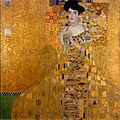Poster
A poster is a large piece of printed paper that has a message, usually with picture of something. Posters are made to be shown in public on a wall or other flat surfaces. They were the main form of public advertising before the web, and they are still used.

Posters are used for advertising, education, propaganda, and decoration.[1][2] They may also be copies of famous works of art.
Chromolithography and the poster
Chromolithography (color lithography) was invented by Engelmann & Son, who were granted a patent in 1837.[3] After that, it was a matter of time before it reached full commercial development.
Because of its low production costs, over the 50 years after the American Civil War, millions of chromolithographs were printed and were sold for under $10. Louis Prang, a Bostonian, produced fine-art subjects, such as still lifes, landscapes, and classical subjects.[4] Nevertheless, it was only after 1847 that the Jules Chéret posters showed their real potential.[5]
Examples
Jules Chéret
- In 1858 Chéret printed his first color poster in France. His art excelled in showing the body in movement.[6]
- Hand-lettered titles were used in harmony with the design.[7] Chéret used design as the dominant features while reducing the text to a minor role.
- The women of Chéret's posters, playful, elegant, and lively were very different from previously depicted prostitutes or puritans.
- Chéret minimized the role of the text. In this poster, all of the relevant information is said in two words.
19th century posters in the US
- General source:[8]
Louis John Rhead
- Louis John Rhead was English, sent to Paris at the age of thirteen to study under Boulanger. When he arrived in America in 1888, he was one of the leaders in the Art Nouveau movement. He created posters for Scribner's and Century magazines.[9]
- In the 1890s Rhead designed nearly one hundred posters. In England and the U.S. he did memorable posters for magazines: Cassell's Magazine, the Weekly Dispatch, The Century, St. Nicholas, Harper's, The Bookman and Scribners'.[10]
- Many consider his use of colors startling, and his compositions sophisticated. He created artwork that in his time looked modern and vanguard.
- In 1895 he won a gold medal for Best American Poster Design at the first International Poster Show in Boston. By the late 1890s, the popularity of poster art declined and Rhead turned his skills to book illustration.[11]
Edward Penfield
- Edward Penfield was the “originator of the poster in America". Edward studied painting under the impressionist George de Forest Brush around 1890. He is mostly known for his advertising ‘placards’ for Harper's New Monthly Magazine.
- Penfield’s first published work appeared in Harper's Weekly in 1891. In his early works, Penfield did ink and watercolor wash illustrations in a similar style to the older generation of graphic artists.[12]
- His trademark linework and use of broad tonal areas developed after his return from Europe. There influences from Japanese prints, the Arts and Crafts movement, and the impressionistic approach of Parisian poster-making.[13]
- Penfield is credited with bringing abstraction to commercial art through his boldly simplified shapes.[14]
Toulouse-Lautrec and Post-impressionism
- Henri Raymond de Toulouse-Lautrec (1864-1901), the deformed son of an aristocratic family, went to Paris in 1882. He became a part of the bohemian community of Montmartre with its nightlife of cabarets, cafes, restaurants, sleazy dance halls and brothels. 1892/3.[15]
- Lautrec was deeply influenced by Japanese woodblock printing: from the 1850s onwards, Japanese artwork flowed into the west. The nightlife of Montmartre inspired the content of his work. 1892.[16]
- The women accepted him as a fellow outcast. They let him to wander about, sketching and painting freely. He grew close to his models, brought them presents, and took them to his studio, restaurants, circuses, or theatres during their time off. 1892.[17]
- Lautrec wove the text into the graphics, but here there is almost no text. Still, this poster probably has all the necessary information. People would know who Cadieux was, and where the theatre was. Shows a terrific sense of movement. 1893.[18]
Art nouveau posters and the impact of graphics on painting
- The English graphic artist Aubrey Beardsley illustrated periodicals. Clearly art nouveau, with elegant and flowing lines; and splendid elongated figures. Beardsley suggested vice and moral corruption, where Lautrec simply showed people.[19]
- Alphonse Mucha was another influential Art Nouveau designer. The subjects of his posters are often beautiful, with joyous young women, flowing lines, and decorative flowers. He used an innovative soft pastel coloring scheme in his posters.[20]
- Henri Privat-Livement's typical use of organic forms in this poster for a seaside casino.
- The works of Gustav Klimt, the Austrian painter, are an example of the influence of graphic design on painting.[21] This portrait of Adele Bloch-Bauer shows many of the influences of the graphic design of those times.[22]
Posters in the first half of the 20th century
Posters were used for war propaganda, to encourage young people to enlist in the army, and to sell government war bonds. From a strictly artistic view, the posters were unimaginative and far from the masterpieces of the late 19th century posters. The posters almost all came with a caption to bang the message home.
- This is virtually a copy of the famous British poster featuring Lord Kitchener 'Your country needs YOU' (1914).
- No sign of art nouveau here; simplicity itself in a British poster designed for use in the USA. 1917.[23]
- Among the propaganda war posters, this stands out, with its distinct blend of sympathy and help. Norman Rockwell, 1918.[24][25]























